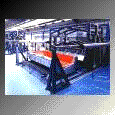VARIOUS
PROCESSING METHOD
There are various production methods today. Each process has its own
characteristics as well as limitations as to part size, shape, production
rate, compatible reinforcements and suitable resin systems used.
HAND LAY-UP PROCESS
The most common application is the Hand lay-up process. It provides only
one finished surface. The hand lay-up method involves placing the
fibreglass reinforcement, in the form of chopped strand mat, onto the
mould and applying the catalyzed resin by brush/roller. This method
offers good control of materials, enabling controls of thickness and
resin to glass ratio.
|

Hand Lay-Up Process
|
|

Spray-Up Process
|
SPRAY-UP PROCESS
Also used for low to medium volume production, spray-up moulding is used
for similar products as hand lay-up, but allows for greater shape
complexity. A chopper gun is used to deposit the chopped strand
reinforcement and resin. This method is more operator dependant to get the
desired result, but this is additionally monitored by the use of flow
meters and scales for materials. Its advantage is that it is quicker and
cheaper for production of large items, or large numbers. As size
diminishes it becomes more wasteful due to overspray.
|
|

RTM Process
|
RTM PROCESS
The resin injection method is used where high production rates or specific
criteria such as critical wall thickness or two moulded faces are
required. RTM products require more expensive reinforcement, the resin
pigment is an additional cost, there is considerable waste, and post-moulding
trimming is always required to remove the flash. Open moulded products can
be trimmed to size in the moulds.Reinforcement is placed in the bottom
half of the mould. The mould is then closed and clamped and catalyzed
resin is then pumped into the mould under pressure until the mould is
filled.
|
|